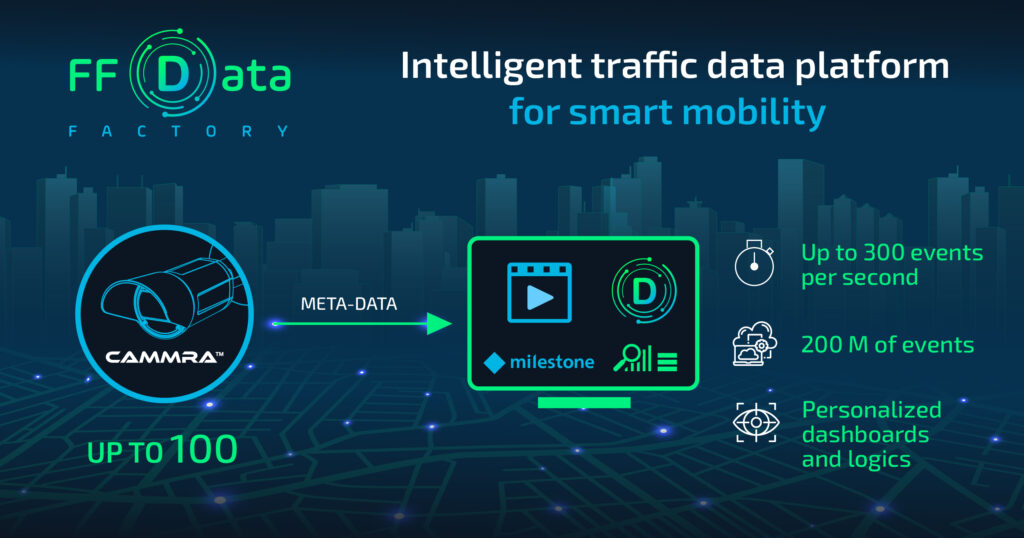
Every day, dozens of cars pass through the streets of small towns. On the main highways and in the big cities that number of cars can reach into the tens or even hundreds of thousands.. According to statistics, there are 0.6 cars per person in Germany or Luxembourg, and 1.3 per person in the USA. With such trends, many cities are already overcrowded and packed with cars, leading to a number of problems including the increase of pollution, particularly CO2. It is possible to solve this problem by using environmentally friendly transport, such as cycling, urban and suburban public transport in accordance with European standards. In addition, modern CCTV technology from video surveillance to traffic detection on the roads can play an important role in traffic control and flow management.
We at FF Group are more familiar with urban traffic control problems and how to solve them, communicating daily with clients from state and local authorities. In recent years we have visited countless Czech and Slovak, as well as German, Polish, Belgian and Swiss cities and their police stations. We are well acquainted with video surveillance systems that are built by our partners – distributors and integrators. Therefore, when developing our ANPR solutions and smart platform, our team takes into account all the demanding problems of cities, regions and some countries from Europe to South Africa, Australia or New Zealand.
The main problem for municipalities and police today is not getting traffic data about transport at a moment’s notice, but to be able to look at this data in a specific period of time, up to a long-term perspective. Often it takes work with current data in order to draw conclusions about a specific situation. At the same time, there is no centralized data collection which allows you to get a fairly global view within the city, region or the whole country. Until today, there was no accessible and simple tool for working with traffic data on the market. The FF Group team was one of the first to develop the Intelligent traffic data platform for smart mobility, which allows it to search traffic data incredibly fast and very intuitively.
Before we figure out how such a platform works and what it does for municipalities and the police, how it facilitates the work of integrators and distributors in building traffic management systems, let’s take a look at an important part of these systems – traffic sensors. At present, full-fledged networks of traffic sensors have not been built in European cities, which allow obtaining ready-made data from cameras for subsequent modeling of traffic flows. For example, in the Czech Republic, the Ministry of Transport has data from only a few dozen cameras located throughout the country. At the same time, the police collect data for their database from 15 cities or districts.
As you can see, there is little sensor traffic in the Czech Republic and, as a result, the database is very small for analyzing and planning the construction of motorways and key roads in the coming decades. Such analysis and planning requires a unified traffic monitoring system and full access to all nearby cities and districts. Similar examples exist in Europe, but they are sporadic.
But how can our smart platform FF Data Factory be useful today and to whom? First of all, it can help every small city and, of course, larger ones, by becoming part of a traffic monitoring system. According to the „think global, act local“ rule, it’s best to first understand each unified microsystem before embarking on a nationwide project. Only if there is accurate data from sensors at the lowest local level does it make sense to move higher.
Until recently, building traffic monitoring systems was an expensive undertaking with significant investments in a massive IT infrastructure with a powerful data center. Investments amounted to the order of tens and hundreds of millions, often completely inaccessible to small towns.
The first prerequisite in building cost-effective systems is high-quality IP cameras with open platforms that allow you to analyze traffic data on the camera, which saves a huge amount of resources. For example, there is no need for optics, a server, and video recording for analysis.
With next generation traffic cameras, it is easy to choose the right one for your installation conditions (place the camera just next to the road or up to 50 meters away). The pricing policy is quite comprehensive from simple and convenient software from well-known brands, such as our CAMMRA installed on the Axis camera (from 2 thousand euros) to double supersensors with a computer inside for tens of thousands of euros.
The second condition for the full functioning of modern systems is the centralized collection of traffic data for each city, region or police station. Many users rely on traffic data (often video data) to be able to process the databases of their video management system. Some systems are better adapted to this, others are worse, but in principle none of them processes traffic data of 10 or even 100 of events per second.
There have been attempts to create software inside video management systems that work with traffic data, but this requires a huge amount of computing resources. At the same time, the system does not work very quickly and efficiently. In general, such an “all-in-VMS solution” is suitable for small systems, for example, a logistics complex or a factory with several hundred events (entries, exits and transits) per day on several cameras.
But a city or region whose system registers 10s to 100s of passes every second will generate more than 100,000 such events every day. These are several million events per month and tens-hundreds of millions of events per year. And in all this data array it might be necessary to find one specific vehicle. At the VMS level, this cannot be done quickly, since a specialized database is needed just to work with so much traffic data. And the client needs a result in a few seconds and a simple screenshot to confirm the data. Only after this is he interested in video confirmation and details of the event.
In such a situation, a smart platform such as FF Data Factory comes to the rescue, which at present works directly in Milestone XProtect.
At first glance, it may seem that this is another data plugin connected to a VMS. However, none of them has been designed to manage and quickly evaluate huge amounts of traffic data, which are relatively complex. For example, each event has many parameters such as time stamp, information about the vehicle direction, license plate, country of origin/registration of the vehicle, its make, model, color, zone/lane, etc.
Now imagine that several thousand of these data are sent from each camera to the central database. Try to search the database for the necessary information on various combinations of these parameters, and despite the fact that other analysts generate a lot of data in the VMS, such as motion detection, recognition of various objects, face detection, unauthorized gathering, shots, screams, glass breaking, etc.
Therefore, the architecture of FF Data Factory was designed in such a way as to seamlessly process data from several sites simultaneously with dozens of high-speed traffic cameras not only receiving and storing a large amount of traffic data, but also quickly receiving and analyzing it.
This is to say that the operator who works with Milestone receives a constant overview of the traffic situation in the city using a dashboard with key information. For example, it can pre-configure vehicle groups and alarms that alert you to the presence of a wanted or suspicious vehicle.
The unprecedented variability and flexibility of FF Data Factory when working with traffic data makes it a real revolution in the smart mobility sector. Moreover, it allows you to generate a new dashboard in a few days with its own logic for each client for their individual tasks (insights).
For example, in one city, FF Data Factory can track the number of truck passes in historical parts of the city, in another city it can calculate the average time required to travel around the city, and in the third place it can track the movement of garbage trucks and buses.
Another client can use FF Data Factory as a central search platform, for example, to search for defaulters by car number and blacklist them, or, without knowing the license plate of the car, find it by make, brand, color or country of registration.
And all this is just the beginning of FF Data Factory’s journey in working with traffic data. By the end of 2022, we will add a new search parameter, namely what kind of engine the car has (combustion, electric or hybrid). It will also be possible to obtain information on the definition of a group of emergency vehicles (ambulances and firemen, police). In the longer term, with the help of metadata from partner manufacturers, FF Data Factory will generate important social data, for example, about suspicions of aggressive behavior, about a car that is too loud, about drivers polluting the city with garbage, etc.
As you can see, this fast and flexible platform knows no boundaries. On the one hand, it is able to solve a practical connection to the VMS and conduct a quick search for traffic data there, and on the other hand, it can make a deep traffic analysis based on all the parameters of the detected vehicles.


Oleksandra Plakhota
Head of Sales